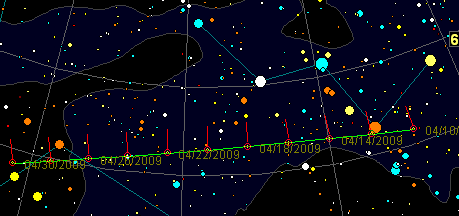A new comet has been discovered that should be the brightest comet in the sky this month. Comet C/2009 F6 (Yi-SWAN) is a long-period comet which will pass within 1.27 AU of the Sun on May 7. The comet is currently around magnitude 8.5 making it bright enough to be seen in small telescopes. Right now the nearly Full Moon will make observing the comet difficult but in a few days the Moon will not be a problem for evening observers. The comet is located north of the Sun. For southern hemisphere observers, you are out of luck. For northern observers, the comet can be observed in both the evening and morning sky.
The below orbit diagram shows the position of the comet at perihelion. Note the high inclination (angle between the orbit of Earth and the comet) of 85 degrees. As a result, the comet is orbiting almost perpendicular to the orbit of the planets. Unfortunately, the comet is rather far from Earth. It has already come as close to Earth as it can at ~1.8 AU and will slowly move away with time.

Currently the comet is located in Cassiopeia. It is moving to the east and will enter Perseus by mid-month. The comet should continue to brighten as it approaches perihelion and may be as bright as magnitude 8.0.

The comet was found by Dae-am Yi of Yeongwol-kun, Gangwon-do, South Korea on March 26. He noticed the obvious blue-green glow of a comet on 2 images he took with a Canon 5D digital camera and a 90-mm f/2.8 lens. According to a post on the MPML mailing list by Maik Meyer, this is the 1st comet discovered by and named for a Korean citizen in the modern age. There were first sightings of comet by Koreans in the 18th century before the comets were named for their discoverers.
The other discoverer was Robert Matson of Irvine, CA. Mr. Matson found the comet on a series of images taken with the SWAN instrument on the SOHO (Solar Heliospheric Observatory) spacecraft starting on March 29. The SWAN insturment images the entire sky for solar Lyman-alpha particles that are backscattered off of neutral hydrogen atoms. In this way, SWAN can monitor the activity of the far-side of the Sun. This instrument is also excellent at detecting the glow of hydrogan in the extended coma of comets.


Can we see the comet? If yes when?
Please give when we can view it in India?
Hi Santosh,
From India, Comet Yi-SWAN is visible very low in the northwest after evening twilight and very low in the northeast before morning twilight.
The comet is requires a telescope to be seen. If you live in a very dark location, then a small telescope will work. If your sky is bright it will be much harder to see. In Tucson, I can see stars down to magnitude 5.0 to 5.5 with my naked eye. But even then I was unable to see the comet in my 12″ telescope. If the comet were higher in the sky, it would be a much easier object.
Good luck,
– Carl
Sir can you told me which comet i see in next plse give me list
we are at school right now